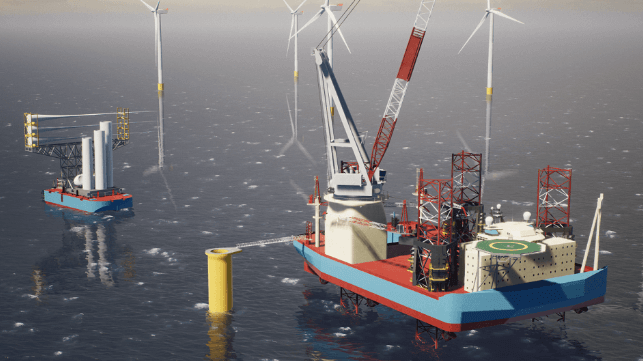Maersk Supply Service Brings Feeder Concept to EU Offshore Wind Market

Maersk Supply Service is planning to take an operating concept from the budding Jones Act offshore wind market and bring it back to Europe. The firm is working with offshore engineering firm GustoMSC to perfect a variant of a feedering concept that could be used for wind turbine installations in European waters.
Feedering allows the jack-up wind turbine installation vessel (WTIV) to stay at the offshore construction site while a smaller tender vessel goes back and forth to a service port to load out turbine components. This keeps the ultra-high-value jackup crane asset on scene and working, without taking it off-task for the nonproductive time of driving into port.
For the Jones Act market, where shipbuilding costs up to four times as much as in other parts of the world, feedering allows the costliest vessel asset in the operation (the WTIV) to stay offshore and avoid carrying cargo between U.S. points. This limits cabotage requirements to the smaller, craneless feeder vessels, reducing capex and opex. The first wind farm in U.S. federal waters, Block Island Wind, was built with a foreign WTIV and an American feeder ship.
Maersk has already designed a proprietary feeder-based WTIV for the Jones Act market based on this operating model, and it centers on a patented load transfer system to enable the safe transfer of cargo. The project began in 2019, and Maersk Supply signed a contract with the BP/Equinor joint venture Empire Wind to build and charter the vessel. Sembmarine will build the foreign-flag WTIV portion in Singapore. Kirby Corporation holds the contract to provide the Jones Act compliant barge feedering capacity, including two new barges and two new tugs built in the U.S.
“The new feeder solution equips Maersk Supply Service with a methodology that ensures a radically more efficient installation, which will in turn enable developers to release their supply chains more quickly and lead to faster revenue generation from their windfarms,” said Maersk Supply CCO Jonas Munch Agerskov in 2022.
Maersk Supply Service is now adapting the same concept for European waters, where offshore wind is expected to take off in years ahead. The patented WTIV will stay on station at the wind farm site, and only tugs and barges will sail to and from an EU port for components. Maersk Supply Service believes that this will be more than 30 percent more efficient than conventional WTIVs - and will have a wider weather window. In fact, the company believes that they will be so tolerant of poor surface conditions that they will be able to operate year-round.
"As the [proprietary WTIV] itself does not sail into ports, this can solve some of the bottlenecks we currently see in Europe, where only a few ports are large enough to handle the growing wind turbine sizes,” said Agerskov.
